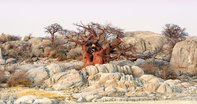
Name
Baobab (Adansonia digitata)Other names
Monkey-bread tree, upside-down tree, bottle tree, baobab, tabaldi and boabDescription
All species of baobab trees are deciduous, meaning they shed their leaves annually. This tree is very unique in its appearance and can grow to great sizes, ranging from 5 to 20 m in height. Carbon dating has shown that they can live as long as 3000 years.
A very old and hollow baobab in Zimbabwe is so big it can hold up to 40 people inside its trunk. Some baobabs, have been utilised as buildings by humans over the years, such as prisons, shops, houses, bus shelters and storage barns. Its trunk varies from a pinkish-grey to copper in colour, and is smooth and glossy in texture.
When its leaves shed, the baobab looks like a tree that has been planted upside-down – its finger-like branches spreading like roots. These trees do not die easily, surviving fires and growing new bark if they have been stripped. When they eventually die, they collapse from rotting on the inside and leave mounds of fibres behind.
People think these majestic trees disappear rather than simply die. Because of their size and age, an old baobab tree can form and sustain its own ecosystem. Numerous insects and animals, big and small, are dependent on the baobab.
Baboons feed on the baobab’s fruit, bush babies and fruit bats drink its nectar and pollinate its flowers, birds nest in its branches, and elephants have been reported to flatten entire trees and eat them. The San people believe that the baobab does not simply grow as other trees do, but disappear after falling to the ground when old and fully grown, like a magical tree.
A young version of this tree looks distinctly different to an older version.
Baobab Flowers and Fruit
The baobab’s flowers are big and white and open at night and produce a pungent scent to attract the nocturnal bats to feed on their nectar. Its fruit can grow up to 30 cm (1 foot) in length, containing vitamin C and tartaric acid.
When soaked in water it flavours a refreshing drink, or when ground up and roasted it can be used to make a drink similar to coffee. The pollen is used to make glue, and the leaves can be eaten when boiled. Its bark is pounded and used to weave baskets and mats, make rope, paper and cloth.
Baobab Uses
Most trees die when bark is striped from their lower trunk. The baobab, however, not only survives this but grows new bark where stripped. The bark is used for its fibre to make cloth, rope, baskets, musical instrument strings and waterproof hats.
Fresh baobab leaves can also be eaten, and has a vegetable-like quality similar to spinach. It also has medicinal uses for treating insect bites, asthma, bladder and kidney disease and other ailments. The fruits and seeds are flavourful and nutritious, and enjoyed by numerous species.
Baobab Native Legends
Tribes living along the Zambezi River tell that when the world was young and new, baobabs stood proud, tall and straight but then became arrogant towards other growths. This angered the gods and they uprooted the baobabs, shoving them back into the ground upside down.
Their flowers are now haunted by evil spirits, causing anyone who picks a flower to be killed by a lion. People in other regions, however, believe that drinking water used to soak baobab seeds will serve as protection from being attacked by a crocodile Another story of the baobab’s strange appearance tells that the god Thora did not want baobabs growing in his garden, throwing them over the wall of Paradise to the Earth. The tree landed upside-down, but did not stop growing.
There is an enormous baobab in Zambia that is believed to be haunted by a python. The story tells that before the white man’s arrival, a python lived in the hollow trunk of the tree and was worshipped by the local people. It answered their prayers of rain, good harvests and hunting.
The first white hunter to see the python shot it, leading to dire consequences. People claim to hear a low, continuous hissing sound on quiet nights coming from this tree. One of the biggest baobabs in the Kafue National Park is named Kondanamwali, meaning ‘the tree that eats maidens’.
The story goes that four young maidens lived in the shade of the baobab, and the tree fell in love with them. Once they reached puberty, they sought husbands. This made the tree jealous. One night during a thunderous storm, the baobab opened up and locked the maidens inside itself.
There is now a rest camp built in the tree’s branches, and it is said that the maiden’s cries can be heard on stormy nights. Along the Limpopo River, local people believe that a young boy will grow into a big man when washed in water that has been used to soak baobab bark. Tribes in Limpopo wash their baby boys’ toys in water used to soak the bark of a baobab so their sons will grow big and strong. It is also believed that women who live in areas where many baobabs grow will have more children than women who live in other areas.
This has been proven to have a scientific explanation, as baobab leaves are eaten and high in vitamin C. The leaf thereby makes up for nutritional deficiencies in the women’s diets, resulting in them being more fertile.